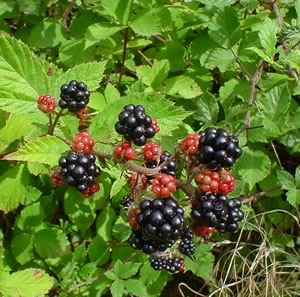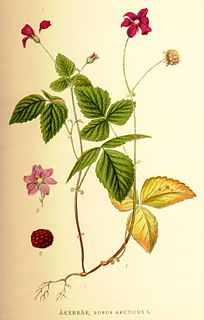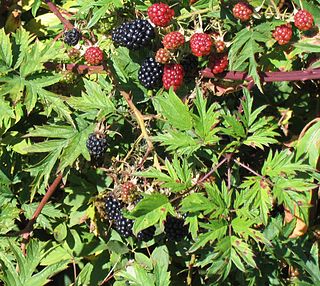
Rubus is a large and diverse genus of flowering plants in the rose family, Rosaceae, subfamily Rosoideae, with over 1,350 species.

The raspberry is the edible fruit of a multitude of plant species in the genus Rubus of the rose family, most of which are in the subgenus Idaeobatus. The name also applies to these plants themselves. Raspberries are perennial with woody stems. World production of raspberries in 2020 was 895,771 tonnes, led by Russia with 20% of the total.

Rubus idaeus is a red-fruited species of Rubus native to Europe and northern Asia and commonly cultivated in other temperate regions.

Rubus spectabilis, the salmonberry, is a species of bramble in the rose family Rosaceae, native to the west coast of North America from west-central Alaska to California, inland as far as Idaho. Like many other species in the genus Rubus, the salmonberry plant bears edible fruit, typically yellow-orange or red in color, resembling raspberries in appearance.

Rubus parviflorus, commonly called thimbleberry, is a species of Rubus native to northern temperate regions of North America. The plant has large hairy leaves and no thorns. It bears edible red fruit similar in appearance to a raspberry, but shorter, almost hemispherical. It has not been commercially developed for the retail berry market, but is cultivated for landscapes.

Rubus arcticus, the Arctic bramble or Arctic raspberry, is a species of slow-growing bramble belonging to the rose family, found in arctic and alpine regions in the Northern Hemisphere.

Rubus leucodermis, also called whitebark raspberry or blackcap raspberry, is a species of Rubus native to western North America.

Rubus pensilvanicus, known commonly as Pennsylvania blackberry, is a prickly bramble native to eastern and central North America from Newfoundland south to Georgia, west as far as Ontario, Minnesota, Nebraska, and Arkansas. The species is also established as a naturalized plant in California.

Allium validum is a species of flowering plant commonly called swamp onion, wild onion, Pacific onion, or Pacific mountain onion. It is native to the Cascade Range, to the Sierra Nevada, the Rocky Mountains, and other high-elevation regions in California, Oregon, Washington, Nevada, Idaho and British Columbia. It is a perennial herb and grows in swampy meadows at medium and high elevations.

Rubus laciniatus, the cutleaf evergreen blackberry or evergreen blackberry, is a species of Rubus, native to Eurasia. It is an introduced species in Australia and North America. It has become a weed and invasive species in forested habitats in the United States and Canada, particularly in the Northeast and along the Pacific Coast.

Rubus armeniacus, the Himalayan blackberry or Armenian blackberry, is a species of Rubus in the blackberry group Rubus subgenus Rubus series Discolores Focke. It is native to Armenia and Northern Iran, and widely naturalised elsewhere. Both its scientific name and origin have been the subject of much confusion, with much of the literature referring to it as either Rubus procerus or Rubus discolor, and often mistakenly citing its origin as western European. Flora of North America, published in 2014, considers the taxonomy unsettled, and tentatively uses the older name Rubus bifrons.
Eurybia radulina, commonly known as the roughleaf aster, is an herbaceous perennial in the family Asteraceae. It is native to western North America, where it is present primarily west of the Cascade Range in both Canada and the United States. Its habitats include dry rock outcrops, slopes, edges of forests, and oak woodlands.

Rubus ursinus is a North American species of blackberry or dewberry, known by the common names California blackberry, California dewberry, Douglas berry, Pacific blackberry, Pacific dewberry and trailing blackberry.

Toxicoscordion micranthum, the smallflower deathcamas, is a flowering plant in the genus Toxicoscordion. It is native to Oregon and California, primarily in the Coast Ranges from Douglas County to Napa and Sonoma Counties, with isolated populations in Lassen, Plumas, Santa Clara, and San Benito Counties. It is a member of the serpentine soils flora.

Artemisia arbuscula is a North American species of sagebrush known by the common names little sagebrush, low sagebrush, or black sagebrush. It is native to the western United States from Washington, Oregon, and California east as far as Colorado and Wyoming. It grows in open, exposed habitat on dry, sterile soils high in rock and clay content.
Rubus glaucifolius is a North American species of wild raspberry known by the common name San Diego raspberry. It is native to Oregon and California, where it grows in mountain forests.

Rubus lasiococcus is a species of wild blackberry known by the common names roughfruit berry and dwarf bramble. It is native to western North America from British Columbia to northern California, where it grows in mountain forests. In the southern half of its range the plant is commonly found in a plant community in the understory of mountain hemlock and Shasta red fir.

Rubus ulmifolius is a species of wild blackberry known by the English common name elmleaf blackberry or thornless blackberry and the Spanish common name zarzamora. It is native to Europe and North Africa, and has also become naturalized in parts of the United States, Australia, and southern South America.

Rubus allegheniensis is a species of bramble, known as Allegheny blackberry and simply as common blackberry. Like other blackberries, it is a species of flowering plant in the rose family. It is very common in eastern and central North America.
Snow bramble or snowy bramble is a common name for several plants and may refer to:

















